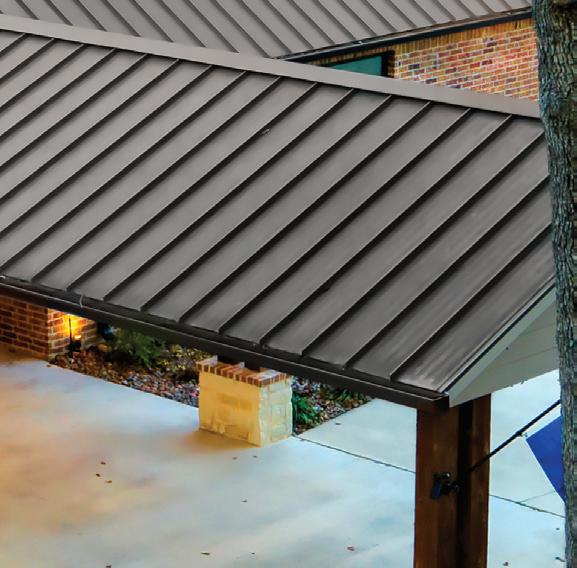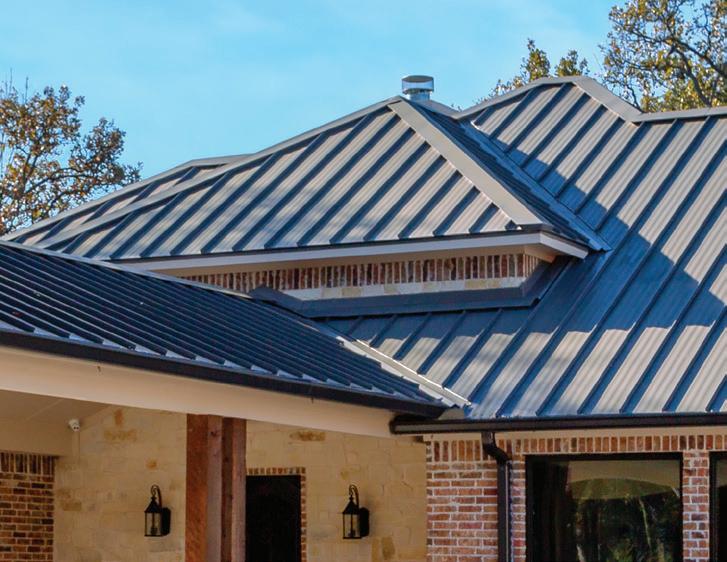Along these LINES



The Power of Support
How our co-op members energize restoration progress Page 20 ALSO INSIDE >> President’s Message Page 4 Manager’s Message Page 5











How our co-op members energize restoration progress Page 20 ALSO INSIDE >> President’s Message Page 4 Manager’s Message Page 5







This spring, Louisiana—along with most southeastern states—weathered a series of severe storms. Association of Louisiana Electric Cooperatives, demonstrating its resilience, was able to activate our mutual aid network on a smaller scale to assist our cooperatives with restoration efforts caused by these isolated storms in the southeast. As we enter hurricane season, we stand prepared, fortified by our mutual aid efforts.
Co-ops, united by a spirit of cooperation and community, prepare for major outages and disasters through mutual aid—a collaborative approach to emergency planning. The mutual aid model allows electric co-ops to support each other during times of need. This approach permits co-ops to “borrow” restoration workers from other co-ops, thereby increasing the workforce response to areas impacted by a major outage. It’s essentially about neighbors helping neighbors, even when those neighbors are fellow co-ops located hundreds of miles away.
Electric co-ops operate according to Seven Cooperative Principles. Principles six and seven, Cooperation among
Cooperatives and Concern for the Community, are directly connected to the mutual aid network.
Electric co-ops were formed to provide safe, affordable, reliable electricity to our member-consumers. Being able to restore power efficiently following storms is part of our DNA. During major outages, a variety of equipment is needed to complete repairs, including bucket trucks and other specialized vehicles, utility poles, transformers and wires. Skilled lineworkers, tree trimmers, damage assessors and other key personnel are also often shared among co-ops. These experts provide critical skills and manpower to speed up the restoration process.
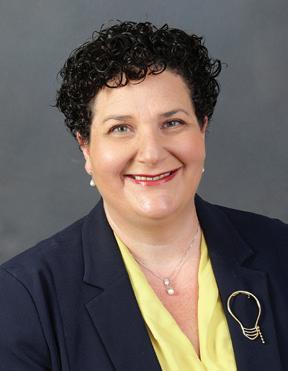
the necessary personnel and equipment, the key ingredients of the mutual aid recipe. These efforts require effective logistics management and experts who fully understand resource allocation and have the know-how to respond under pressure, providing a strong support system for our mutual aid efforts.
ALEC is a nonprofit organization representing the electric distribution cooperatives operating in Louisiana. The Louisiana Electric Cooperatives serve roughly 1 million citizens in 50 parishes. Our mutual aid network, consisting of 26 states working closely with their statewide associations, provides an abundant supply of personnel and equipment when needed most for storm recovery.
Disaster response and mutual aid, crucial aspects of our operations, are managed by electric co-ops and our statewide organizations. These organizations play a vital role in coordination between states, ensuring
Staff
CEO Addie Armato
SAFETY COORDINATOR Ricky Melancon
COMMUNICATIONS AND DIGITAL MARKETING
SPECIALIST Conley Bourgeois
ADMINISTRATIVE ASSISTANT Rhianna Garon
CREDIT UNION
Tanya Carroll, manager
Jody Overhultz, representative
President Dennis Glass
Vice President Michael Heinen
Secretary/Treasurer Roger Dale DeHart
Buxton
Marcotte Lane Davidson
Daniel Berthelot Richard “Dickie” Sitman
Michael Heinen Byron Hardee
Trevor Benoit Roger Dale DeHart
Joe Jarrell Dennis Glass



the source of Louisiana’s food traditions Page 12


BOARD OF DIRECTORS
ASCENSION
Elinda Taillon
EAST BATON ROUGE
Steve Irving
Randy Lorio, Vice President
Jill McGraw
EAST FELICIANA
Mike Anderson
Glenn DeLee
LIVINGSTON
Danny Berthelot, President
Leslie Falks
Dennis Lott, Secretary-Treasurer
ST. HELENA
Tresa Byrd
Richard Sitman
TANGIPAHOA
Melissa Dufreche
WEST FELICIANA
Kevin Beauchamp
CEO & GENERAL MANAGER
Randy Pierce
CHIEF CORPORATE SERVICES OFFICER
Russchelle Overhultz, CEBS
CHIEF ENGINEERING & OPERATIONS OFFICER
Mark Phillips
CHIEF FINANCIAL OFFICER
Peggy Maranan
CHIEF MEMBER SERVICES OFFICER
Galen Dunbar
CHIEF STRATEGY & REGULATORY OFFICER
Jeff Andry
Volume 39, Issue 4
Mission
DEMCO is focused on enhancing the quality of life for members by providing safe, reliable and competitively priced energy services.
Along These Lines (USPS 4089) is published bimonthly by the Association of Louisiana Electric Co-ops Inc., 10725 Airline Hwy., Baton Rouge, LA 70816, in partnership with Pioneer Utility Resources.
Annual Subscriptions: Members $2.18. Nonmembers $5.
Postmaster: Send form 3579 to 10725 Airline Hwy., Baton Rouge, LA 70816.
Periodicals postage paid at Baton Rouge, Louisiana 70821 and additional mailing offices.
DEMCO is an equal opportunity provider and employer.
Each year, the President’s Report is a vital communication tool, showcasing key milestones and providing insights into DEMCO operations.
As your dedicated local co-op board, we are committed to serving you, our valued members. Our mission is clear: to ensure DEMCO delivers electricity that is safe, reliable, and competitively priced to each and every one of you.
Our commitment to excellence doesn’t stop there. Through ongoing professional training and certification, we equip ourselves with the knowledge and skills needed to govern the cooperative effectively. From engineering to finance, we stay informed about industry trends and best practices.

In 2023, all 13 DEMCO directors completed or renewed their certifications through the National Rural Electric Cooperative Association, earning the prestigious Director Gold Certification. This accomplishment places DEMCO among the elite few in the nation, a testament to our dedication to serving you with the highest standards of governance.
Taking a closer look at DEMCO’s 2023 performance, we are proud to report significant achievements. Our kilowatt-hour sales reached 2,281,466,897, serving a membership base of 117,458 throughout the seven parishes we serve. With a total of 9,243 miles of line and a system peak demand of 630 megawatts, DEMCO continues to uphold its commitment to reliability and efficiency.
Finally, we extend our gratitude to our reelected board members. Embarking on another three-year term are Elinda Taillon, representing Ascension Parish, District 1; Jill McGraw, serving East Baton Rouge Parish, District 2; Leslie Falks, representing Livingston Parish, District 7; and Tresa Byrd, serving St. Helena Parish, District 11. Each are dedicated to advancing the interests of the cooperative and its members.
Thank you for your continued trust and support as we work together to power our communities forward.
Sincerely,
Danny
Berthelot
President, DEMCO Board of Directors
Congratulations to these DEMCO members, winners of the random drawing for a $50 gift card. You will each receive a gift card in the mail! Carl L., Larry D., Jazz F. and Adrian P. My DEMCO Registered




Randy Pierce CEO & General Manager
On behalf of the board and executive leadership team, I want to extend our heartfelt gratitude and immense pride in the remarkable efforts demonstrated by our staff in response to the recent storms in April and May. We are proud, and we hope you are too, of the dedication and hard work exhibited by our linemen, visiting co-op crews, contractors and support personnel in swiftly restoring essential services to our co-op members.
The teamwork and resilience shown during these challenging times have been nothing short of inspirational, showcasing the true spirit of our cooperative.
As hurricane season began in June and forecasts predict an above-average season, I want to provide you with insight into what happens when a storm hits our service area and how DEMCO responds. Not only do I encourage you to have a plan, but I also want to assure you that we do.
Preparedness is key, and we have comprehensive strategies in place to tackle adverse weather conditions efficiently and effectively.
Our linemen, visiting co-op crews and contractors spring into action, working tirelessly in the field to swiftly restore essential services to you, our valued members. They usually face rugged terrain, swamps, and other obstacles (insects, snakes, etc.) as they navigate extensive damage before any repairs and reconstruction can begin.
Their commitment to safety and service is unwavering, even in the most challenging circumstances.
Behind the scenes, dedicated DEMCO staff ensure our crews are well cared for by coordinating meals, housing and laundry to support their efforts. This logistical support is crucial, enabling our frontline

workers to focus on their critical tasks without additional worries.
Every department plays a vital role—including warehouse, purchasing, finance, engineering, operations, safety, loss control, member services, right-of-way, project management, fleet services and HR. The seamless coordination among these departments ensures that every aspect of our response is covered, reinforcing our strength as a cohesive unit.
While this work may not always be visible, it is happening throughout the co-op.
As we reflect on the challenges we have already faced and prepare for future storms, we recognize the important roles of everyone here at DEMCO as well as our fellow cooperatives, contractors and others who join to help us recover following catastrophic events. Together, we demonstrate the true power of unity and solidarity, which is the highlight of being part of an electric cooperative in the United States.
The collective effort during times of crisis truly exemplifies the cooperative principle of Cooperation Among Cooperatives, highlighting our shared commitment to serve.
Being a local electric cooperative means our members are not just customers—you are our neighbors, friends and family. You are the owners of the cooperative. We deeply appreciate your patience, understanding and support during these challenging times.
Your continued trust and cooperation fuel our drive to provide exceptional service and support, especially when it matters most.
Thank you for your continued support and for being part of our cooperative community. Together, we will continue to overcome challenges and build a stronger, more resilient future. We power preparation




Visit DEMCO.org and download a comprehensive hurricane checklist and safety tips guide. Empower your family to be storm ready and in charge.

/DEMCOLouisiana

ABOVE: Association of Louisiana Electric Cooperatives staff gather before a busy day.
RIGHT: From left are Dane Hocott, Washington-St. Tammany Electric Cooperative; Randy Pierce, DEMCO; Addie Armato, ALEC; Joe Jarrell, WSTE; Mike Heinen, Jeff Davis Electric Cooperative; Louisiana’s Department of Agriculture and Forestry Commissioner Mike Strain; Matt Peters, South Louisiana Electric Cooperative Association; Johnny Bruhl, WSTE; and Kevin Turner, Beauregard Electric Cooperative Inc.
BELOW: From left, Randy Pierce, DEMCO; Dane Hocott, WSTE; Mike Heinen, JDEC; Matt Peters, SLECA; and Addie Armato, ALEC, meet with Gov. Jeff Landry’s office to discuss cooperative issues.
Association of Louisiana Electric Cooperatives and members hosted the Taste of Louisiana Cookout for elected officials. The afternoon was spent at the Capitol, meeting with legislators and ended with some Louisiana home cooking.
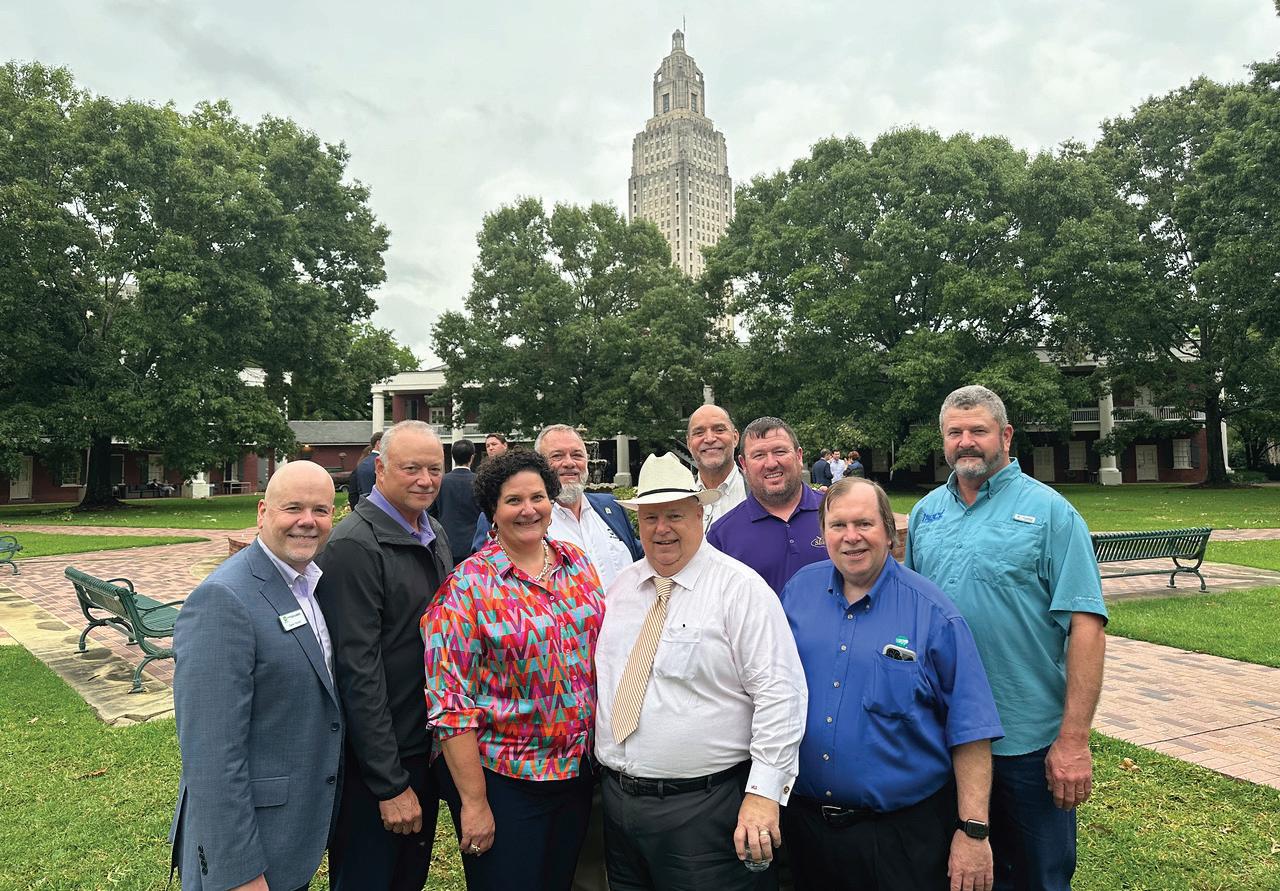
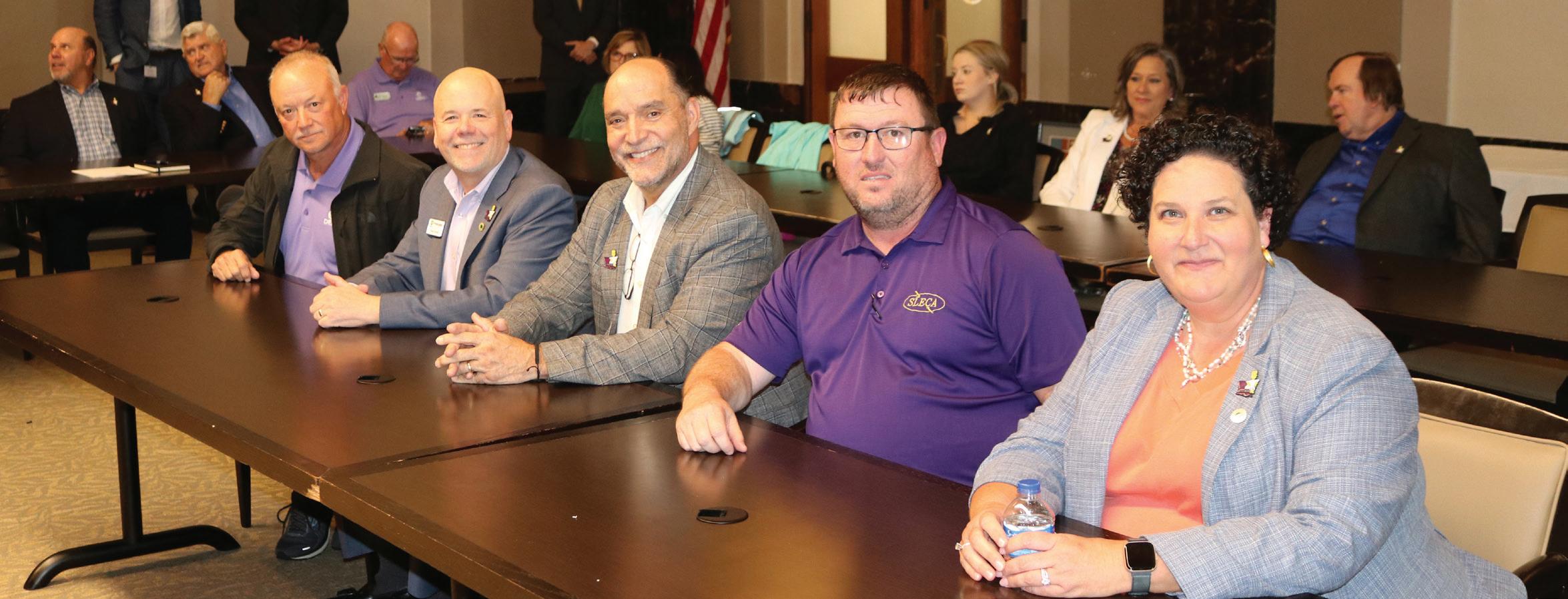



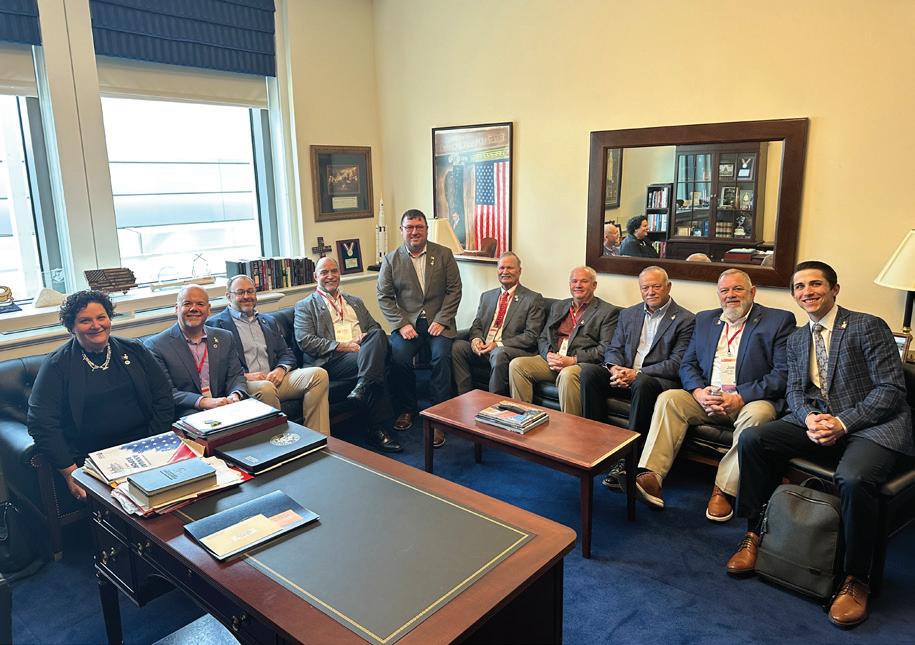
Louisiana electric cooperative leaders met in April with the state’s congressional representatives in Washington, D.C., to discuss topics important to the member-consumers they serve. The visit coincided with the National Rural Electric Cooperative Association’s Legislative Conference, which welcomes co-op grassroots advocates from across the country to the nation’s capital each year.
In the aftermath of a powerful storm, the urgency to restore power often meets a common sentiment: “Just turn it back on already!” However, this statement stems from a common misconception.
There’s no wizard behind a curtain holding the switch, nor is there one person with all the power at their fingertips. The truth of power restoration after a major outage is far more intricate than meets the eye.
Communities—especially in Louisiana, where we’re all too familiar with the hardships imposed by brutal weather conditions—understandably yearn for the return of electricity amid the chaos. It’s crucial to recognize that power restoration is not as straightforward as it may seem.
Behind the scenes, amid the elements of the storm or in its aftermath, dedicated crews embark on a meticulous process to assess and repair the damage inflicted.
Navigating the complexities of the electric grid demands
STEP 1: Inspect Transmission Towers and Lines
High-voltage lines supply power to substations, which serve thousands of members. Repairs at this level are necessary in order to receive the power supply we distribute.
STEP 2: Examine Local Distribution Substations
Each substation serves hundreds or thousands of members, and correcting issues here can quickly restore power to thousands of members.
STEP 3: Inspect Main Distribution Lines
These lines deliver power from the substation to large groups of members in towns and communities, including critical infrastructure such as hospitals and water treatment plants.
STEP 4: Check Tap Lines
Smaller branches from the main power lines that serve streets and neighborhoods. Tap lines deliver power to transformers outside homes, businesses, and schools.
STEP 5: Address Service Line Issues
Problems between your house and the transformer on a nearby pole are the final step, restoring power to members home by home.
expertise and precision. Crews must identify and isolate damaged sections while rerouting power through alternative pathways, all with careful consideration and meticulous planning to minimize disruption to affected communities.
Safety is paramount throughout the restoration process. Before power can be safely restored, crews ensure the safety of individuals and infrastructure, coordinating hundreds— sometimes thousands—of crew members in the stormwrecked areas. Their dedication, expertise and commitment to safety are commendable.
Through education and insight, we can truly appreciate the complexities involved in power restoration and the remarkable efforts undertaken to ensure safe and reliable electricity for our communities.
Let’s also remember electric crews deserve to return home safely, ready to answer the call of duty when the next storm strikes.



By Cheré Coen
When her pan-seared red drum over tomato polenta with a crawfish cream sauce earned Amanda Cusey the 2022 Louisiana Seafood Queen title, many people likely thought the Lake Charles chef was a Bayou State native. However, Amanda’s life and career have taken her around the world, landing her in Louisiana only because her parents found work in the Lake Charles area.
from
“Butter makes everything better.”
“Don’t be afraid to try something new, and don’t be afraid to fail. And don’t be afraid to be weird.”


“Don’t overcook seafood. Seafood can be very delicate. If undercooked, you can always bring it back up.”

Originally from Flagstaff, Arizona, Amanda was living in North Carolina when her parents, both Chicago natives, encouraged her to join them in England, where they lived at the time. She accepted their offer and attended Cordon Bleu training at Tante Marie Culinary Academy in Surrey.
Amanda later worked in English gastropubs, an American diner in Ireland, and under chefs Kristan Burness and Brendan Ward at Fiorentina in Dublin, where she ultimately earned the head chef position. She worked briefly with Michelin star chef Oliver Dunne at his Italian-inspired pop-up restaurant, Eatily, in Dublin’s city center.





When Amanda’s parents grew tired of cold English winters, they began planning their return to the States. An engineering job brought them to Lake Charles, and Amanda followed. At first, the Southwest Louisiana town took some getting used to, but the hospitality Acadiana is known for quickly won her over.





















































“It’s quite grown on me,” Amanda says.
She first developed traditional Italian dishes inspired by her years in Europe to mix with Louisiana influences at The Villa in downtown Lake Charles. Now, she helms the kitchen at The Terrace restaurant at Lake Charles’ Family Entertainment Center, melding her European training with local dishes, flavors and ingredients.
The casual restaurant allows Amanda to bring her elevated cuisine to the masses. Dishes include shrimp and grits, fried blue oyster mushrooms with house-made garlic aioli, flatbreads, and fried shrimp coated in Bayou Satsuma Rum and toasted coconut.
In addition to her seafood title, Amanda was also awarded the title of Best Chef in Lagniappe magazine’s Best of SWLA awards, which was voted on by readers. She is the second woman to earn this recognition and the first Lake Charles chef.
She also headed to Charlotte, North Carolina, with chef Lyle Broussard of L’auberge Casino Resort of Lake Charles in 2023 to be paired with North Carolina chefs in a restaurant takeover experience.
The accolades have been “surreal, a really cool experience,”
Amanda says.
Seeing Lake Charles’ culinary scene grow during the past eight years has also been rewarding.
“It’s been cool to watch,” she says. “The city’s definitely got a whole lot going on.”



















½ cup red peppers, diced
½ cup shallots, finely diced
1 pound Louisiana lump crabmeat, cleaned
1-2 lemons, depending on size, zested and juiced
¼ cup parsley, chopped
2 tablespoons garlic, freshly minced
2 teaspoons Cajun seasoning
1 cup panko breadcrumbs
¼ pound butter, melted
Salt and pepper, to taste
2 tablespoons oil
Saute the peppers and shallots until just tender. Add to a mixing bowl and combine with the rest of the ingredients. Adjust seasoning as needed. Cover and refrigerate for about an hour. Remove from fridge and form cakes to your desired size. Heat the oil and pan sear each side of the cakes until golden brown. If you made large cakes, you may need to pop them in the oven to heat them completely through.







































































































By Cheré Coen





























Louisiana is rich in culinary traditions, but how often do you consider where some of the tastiest ingredients originated? It’s even less common for people to experience these rich agricultural traditions firsthand. Fortunately, there are many opportunities throughout the state for folks to delve deeper into our food sources.






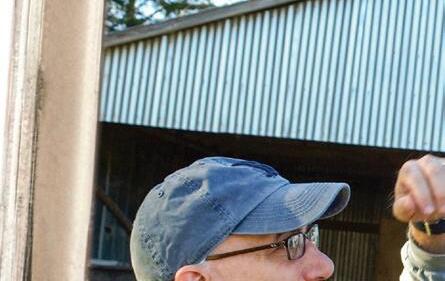












In the growing segment of the travel industry known as agritourism, participating businesses offer visitors a chance to immerse themselves in the agrarian way of life—whether milling rice, trapping crawfish or making hot sauces. From charming family-owned farms that offer accommodations to you-pick farms, destinations across Louisiana invite travelers to experience the rhythm of rural life, savor farm-fresh produce and engage in hands-on activities that celebrate the region’s agricultural traditions.





Breaux Bridge is a short drive from Lafayette, but Bonne Terre Farm feels like another world. This tranquil 10-acre working farm offers two quaint residences to choose from for an overnight stay. Guests can lounge in accommodations stocked with locally made amenities such as soap, fresh eggs, condiments and artwork. Owner Jennifer Gray is a Louisiana ambassador who loves sharing the state’s cultural offerings, and she often takes her guests on guided walking tours of the farm.


Jennifer loves her animal friends, and it shows. Visitors who stay at Bonne Terre don’t have to tour the farm, but Jennifer is happy to introduce them to her turkeys, horse, cow, geese and other friendly


























critters. On a scheduled tour, she expresses her appreciation of animals and the environment, believing immersion in a natural setting might be just the cure for many of modern life’s ills.









“It is a beautiful thing,” she says. “Animal therapy is a true science, and people benefit from it.”
Bonne Terre Farm, French for “good earth,” is for adults only. For more information, visit bonneterrelouisiana.com.


Other farm stays: Splendor Farms in Bush offers guest accommodations along with horseback trail riding, riding lessons and a petting farm. For more information, visit splendorfarms.com.



SonLight Farms in Bogalusa lets visitors pick their own blueberries or, if you’re feeling less hands-on, you can buy the fruit pre-picked and packaged. The family-owned and operated farm grows blueberries without chemicals. Be sure to call ahead,
information, call 985-241-0910 or visit the farm’s Facebook page.
Other berry-picking farms: Landry-Poche Farms in Springfield offers field trips for students and parents in the spring and an annual Family Fun Day. For more information, visit landrypochefarms.weebly.com.






Bachman Blueberries in Bush supplies a bucket, and you pick the berries. The season ends midsummer. Be sure to wear closedtoe shoes and bring water, bug spray and sunscreen. Visit the Bachman's Facebook page for updates.


Just north of Kaplan, Barry Toups takes visitors and residents out to his crawfish ponds, where he explains the business of raising Louisiana’s favorite crustacean. After the tour, visitors can enjoy their caught bounty boiled and served.
Barry is the proprietor of the circa-1903 Crawfish Haven/Mrs. Rose’s Bed and Breakfast, which offers three guest rooms. His tours put visitors in boats puttering through his ponds to retrieve what will be their supper. He fits six people in a boat at a time and pulls up 50 to 100 traps. Afterward, he boils the crawfish and serves up 5 pounds per person.


“We explain all about the life of the crawfish,” Barry says. “It’s very educational. The whole process is two to three hours, depending on how many questions they have.”











































Barry’s crawfish excursions run December 1 through midMay or June 1, depending on that year’s crop. This year was more sparse than usual due to last summer’s drought. He speaks French, so many of his clients hail from across the Atlantic.






Barry’s tours have become so popular, he’s been on many television shows and in The New York Times Magazine. For more information, visit www.crawfishhaven.net.
Other crawfish tours: Jeff Davis Parish Tourism offers crawfish tours that take visitors from the boat to the processing plants. For more information and to book a tour, visit jeffdavis.org/tourism.









Team Voodoo Crawfish Tour is offered near Breaux Bridge. For information, visit www.crawfishtours.com.
Tabasco


The same pepper sauce recipe used by Edmund McIlhenny back in the mid-1800s is still used today at Tabasco’s factory on Avery Island outside of New Iberia. Visitors to the factory get to watch the blend of Tabasco peppers, salt mined from Avery Island and high-quality distilled vinegar aged in white oak barrels create one of the world’s most recognizable brands.



transmission. Attendees see much of the mill’s original equipment, view a slide presentation of Acadian history and browse the Konriko Co. Store that sells cookbooks, crafts, Cajun music and local food products, including Konriko rice fresh off the mill.











Visitors also learn about Tabasco history and artifacts, view the pepper-growing process, get a look at the aging process in the mash warehouse and sniff from the vats where the magic happens. The factory compound also includes a restaurant and gift shop. For information on the self-guided tours, visit www.tabasco.com.


New Iberia is home to America’s oldest operating rice mill, and a tour shows visitors how rice milling came about.
Conrad Rice Mill was built in 1912 and is an example of the factory’s use of a turn-of-the-century belt-driven power




Tours are offered on the hour between 10 a.m. and 3 p.m., Mondays through Saturdays. Learn more at www.conradrice.com.
“It’s remarkably interesting for a short tour,” says New Iberia author Lynn Shurr, who brings visiting guests there. “There is also a good movie beforehand, free samples of coffee and food in the store and the best assortment of souvenirs in the entire town.”





There’s a stretch of northwest Louisiana where sunflowers grow tall and wide. Folks in this region honor this bright, sunny flower every June with the annual Sunflower Trail and Festival in Gilliam, but visitors can enjoy the bright yellow blooms throughout the summer by driving the Sunflower Trail.


This scenic drive along Route 3049 and Sentell Road, south of Belcher, features a sunflower maze, wildflower fields, zinnia blossoms and historic stops, including the Veterans Memorial in Belcher, Crossroad Museum in Gilliam, Northrose Plantation in Dixie and more. Sunflowers along the trail are in full bloom and are expected to last through July.








ALEXANDRIA
Alexandria Farmers Market


NEW ORLEANS
Crescent City Farmers Market







3-6 p.m. Tuesdays, 2727 Jackson St.
LAKE CHARLES
Charlestown Farmers Market
8 a.m.-noon Saturdays, 1001 Ryan St.
Cash & Carry Farmers Market
4-6 p.m. Tuesdays, 801 Enterprise Blvd.
SHREVEPORT


Shreveport Farmers Market
7:30 a.m.-12:30 p.m. Saturdays, through Aug. 24, Festival Plaza, 101 Crockett St.
St. Francisville Farmers Market
8 a.m.-noon Saturdays, barn at 9961 Wilcox St.


New Orleans markets are held weekly at City Park, Uptown Square and Mid-City. Details are online at www.crescentcityfarmersmarket.org.
Red Stick Farmers Market


Year-round markets are Thursdays: 8 a.m.-noon, Pennington Biomedical Center, 6400 Perkins Road; Saturdays: 8 a.m.-noon, North Fifth and Main streets, downtown Baton Rouge. Seasonal markets are 3-6 p.m. Tuesdays at the East Baton Rouge Parish Library, 7711 Goodwood Blvd; and 9 a.m.noon Wednesdays at the Exxon Mobile YMCA, 7717 Howell Blvd.





Natchitoches Farmers Market




8 a.m.-noon Saturdays, through July 27, 100 Rue Beauport
Houma’s Market at the Marina
8 a.m.-noon, first Saturday of the month, downtown Houma Marina
LAFAYETTE





Lafayette Farmers & Artisans Market
8 a.m.-noon Saturdays, Moncus Park























through August




















Weatherizing your home provides energy savings and comfort yearround, especially during summer months when your air conditioner is working overtime.
A home with insufficient insulation and air leaks wastes more than 20% of the energy used to heat or cool the home, according to energystar.gov. Fortunately, most weatherization projects are DIY and can be completed in a day.
The simplest and most cost-effective weatherization strategies include air sealing around windows and exterior doors.
If you have older windows, odds are you have air escaping through cracks and gaps around the frame. If you can see daylight around the frame or if the windows rattle easily, you likely have air leaks. Also check for small cracks around the frame that may not be visible with sunlight.
If you suspect you have leaky windows and plan to apply new caulk, be sure to remove the old caulk and clean the area before application. Caulking materials vary in strength and properties, but you’ll likely need a half-cartridge per window.
Silicone caulk is a popular choice and can also be used to seal joints between bathroom and kitchen fixtures.
Another effective but simple weatherization project is installing weatherstripping around exterior doors. The most common types of
weatherstripping options are V-channel, felt and foam tape. Choose the best for your home by considering temperature fluctuations and weather exposure. Most homeowners opt for felt or foam tape; both are easy to install but need to be replaced every couple of years, depending on wear and tear. Weatherstripping should be installed around the top and sides of the door.
If you see daylight around the bottom of an exterior door, consider installing a door sweep in addition to weatherstripping.
Weatherstripping can also be installed around windows. Another way to improve comfort in your home is with insulation. While this is a more costly project and requires a professional’s help, it’s an effective way to decrease heat flow.
Older homes may need additional insulation to replace older materials or meet newer efficiency standards. Contact a qualified installation specialist if you suspect insulation levels are inadequate.
The best way to identify air leaks in your home is a blower door test. A blower door test helps determine how airtight your home is and identify air leaks.
In addition to saving energy, air sealing can help avoid moisture control issues, improve indoor air quality and extend the life of your heating and cooling system. Weatherize your home to unlock yearround comfort and savings on monthly energy costs. n


The Grid Access Charge is the cost to have access to the grid, regardless of whether or not you use it. This is the fee you pay for that. It replaces the term “Monthly Service Fee”.
The Delivery Charge is the cost to get power from the grid to your meter. It replaces the term “Energy Charge”.
The Wholesale Power Charge is the cost of purchasing electricity that we deliver to you. It replaces the term “PCA”.












































































In today’s digital age, utility scams are on the rise, targeting consumers of water, gas and electricity. Scammers are becoming more sophisticated, exploiting technology to deceive people through various means, such as phone calls, texts, emails and deceptive websites.
Here’s what you need to know to protect yourself:
Recent scams include imposters posing as utility representatives, demanding immediate payment to avoid service disconnection. They may also claim you’ve overpaid and offer a refund in exchange for personal information.
Spotting a scam involves watching for high-pressure tactics, unusual payment requests—such as gift cards or cryptocurrency—and signs of poor communication quality, such
as misspellings and incorrect grammar.
Do not make instant payments or share personal information over the phone or via email. Your co-op provides secure payment options and never demands immediate payment or requests sensitive details via these channels.
If you’re unsure about a communication claiming to be from your co-op, hang up and call the office directly to verify.
To avoid scams, be cautious of unknown individuals requesting personal information, and report any suspicious activity.
By staying vigilant and communicating with your utility provider, you can help protect yourself and your community from fraud. n


As a cooperative, our story goes beyond rebuilding power lines and restoring electricity—it's a testament to the resilience and strength of the communities we serve. Nowhere is this cooperative spirit more evident than in the aftermath of natural disasters like tornadoes, which strike without warning, leaving devastation in their wake.
In mid-April, tornadoes swept through East and West Feliciana parishes, leaving 17,000 reported outages at the peak of the storm. St. Francisville bore the brunt of two EF1 category tornadoes, carving a 20-mile path of destruction—massive trees entangled with more than 100 electric poles and debris.
“I’ve never seen anything like it,” says David Jewell, district manager at DEMCO’s St. Francisville location. “It came really fast, and the building shook.”
Despite the rugged terrain and tangled debris, DEMCO crews and mutual aid crews from electric cooperatives South Louisiana Electric Cooperative Association, Arkansas Electric and Petit Jean Electric, as well as contractors and chainsaw crews, worked
How our co-op members energize restoration progress

tirelessly to restore power to all members by April 15.
Restoring power was only part of the challenge. Crews faced treacherous conditions as they navigated through the tangled mess of debris and rugged terrain. However, their determination and commitment never wavered.
“Our co-op members and the communities we serve are the best,”
DEMCO spokesperson Anne Hawes says in an interview with WBRZ TV, expressing pride in the cooperative’s members and communities. “They know our goal is to get the power back on as quickly as possible, and they also know our people—a lot of them are neighbors. They know our guys out working on the lines—they want them to get home safely. We have so much support during times like these.”
The restoration efforts were not just about restoring electricity; they were about rebuilding lives and communities. Photos captured during the restoration efforts depict crews working tirelessly amid the debris, showcasing the cooperative spirit and resilience of all involved.





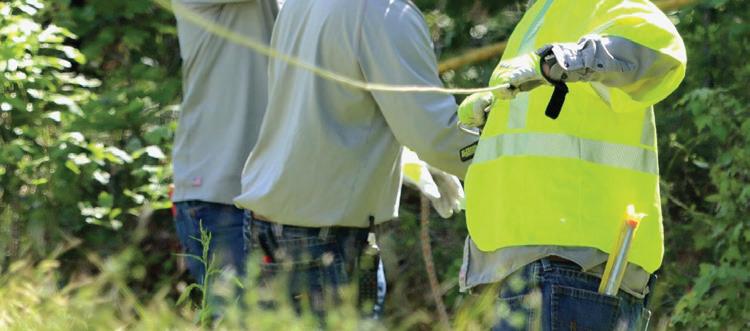
THIS PAGE: Crews often work in very remote areas, so you may not see the work happening. Pictured at top are several bucket trucks and other special off-road equipment and line crews working to replace damaged poles and wires along Thompson Creek in West Feliciana Parish. Above, a crew works to restore power by picking up downed primary wires following the tornado. From
Have you ever watched a video or TV show where a person is cooking a meal, then suddenly they snap their fingers and the meal is plated and ready to eat? That’s called a jump cut. While everyone wishes we could “jump cut” from a power outage to power restoration, it often takes a lot more effort and people to make it happen.
It’s natural for members to have questions about power outages and why it can take time to get the lights back on. Given our reliance on electricity, there’s simply never a good time to be without it.
Here’s a behind-the-scenes look at the restoration process to help members understand what may be happening when the power is out.
1. 2. 3.
We rely on you to let us know if your power is out. When your power goes out, it might be just at your home or a small section of your neighborhood. There is a chance your cooperative may not know about it, and no one has reported it.
When you’re without power, co-op employees might be, too. Because we are local electric cooperatives owned by the members we serve, employees are local. They are your neighbors, friends and familiar community volunteers. It’s a team effort. Every co-op employee works to get power restored as soon as possible. Member service representatives take your calls, engineers and field staff survey damage, the vegetation management team clears hazards, dispatchers organize crews, and communicators keep everyone informed of progress or potential dangers. When the power goes out, everyone on the team works together as quickly and safely as possible to restore it.
4. 5. 6. 7. 8.
Assess the situation. Every outage is different, and in the very beginning it’s hard to know how dangerous it is or whether equipment might need to be replaced. When responding to outages, the first step is to see what happened, then figure out which materials are needed and then create a plan for how to fix the problem(s) without compromising electric flow for the rest of the members. Restoration is normally prioritized by the largest number of members that can get back on in the shortest amount of time. Crews focus on responding first to public safety issues and critical services such as hospitals. Then work is completed that impacts the largest number of people first.
Co-op employees face many dangers. Besides working around high-voltage electricity, crews are on alert for wild animals, weather elements, falling trees and fast-moving cars. If you ever drive past a utility vehicle, please do so slowly.
Flickering lights are a good thing. Some folks mistake flickering lights for outages, but these “blinks” are important because they indicate the equipment worked and prevented a possible outage likely caused by wayward animals or stray tree limbs on the lines. You need a backup plan. If you depend on electricity for life support purposes, you must have a backup plan. Remember, it’s not always known how long restoration efforts will take.
9.
Employees have to plan and eat. If you ever see co-op trucks in a restaurant parking lot while your power is out, know that sometimes employees huddle in a safe, common area to map out the strategy for getting the power back on. Also, crews work long, hard hours during outages and need to take time for meals, just like everyone else.
10.
Sometimes it’s a waiting game. Each portion of the power grid is connected to other electric utilities, and positive relationships are maintained with power providers interconnected to our system. If an outage is due to an issue from their feed into the system, they must repair it.
Periodic power disruptions are inevitable. If the lights go out, know your co-op team is working as quickly and safely as possible to restore power.
There is never a good time for the power to go out, but if it happens on a sunny day, you might be left wondering why. Here are the most common causes of a power outage.
High winds, snow and ice can cause tree limbs to fall on power lines. Other weather effects, like wildfires and lightning strikes, can cause major damage to equipment.
Squirrels, birds, snakes and other animals can inadvertently contact power lines, causing short circuits and disruptions to electrical supply.
Scheduled
Occasionally, we plan outages to perform upgrades or repairs to parts of the local grid. MAINTENANCE
Vehicles can crash into utility poles, bringing down power lines. Construction and excavation work can also result in disruptions to underground lines.





